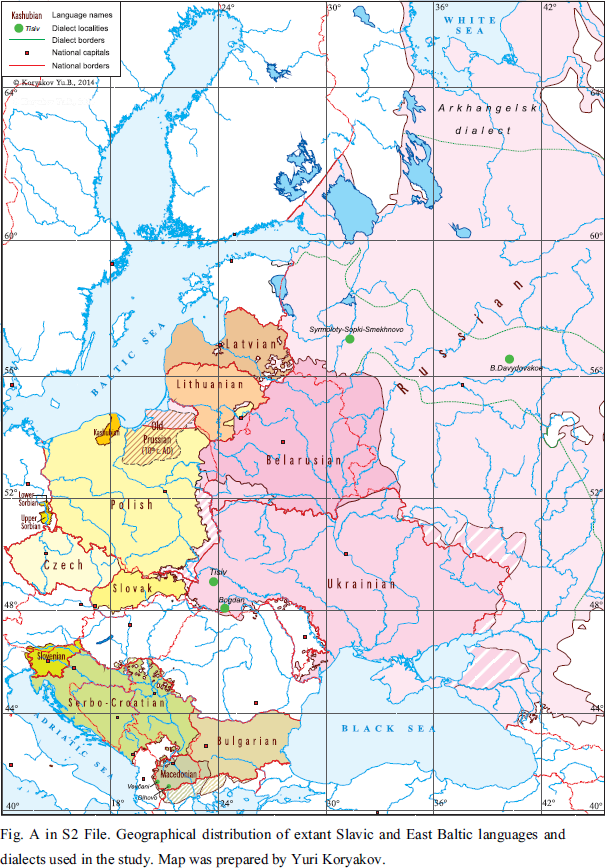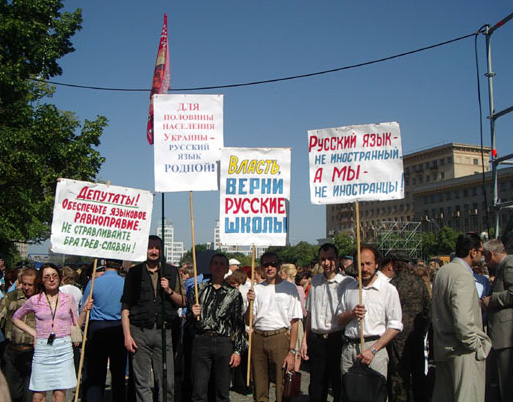|
Pivnichne, Donetsk Oblast
Pivnichne ( uk, Північне; russian: Пивни́чное), formerly Kirove ( uk, Кірове; russian: Ки́рово), is a rural settlement in Bakhmut Raion, Donetsk Oblast, eastern Ukraine. Population: In 2016, Kirove was renamed to Pivnichne, conforming to the law prohibiting names of Communist origin. History Russo-Ukrainian War Russian invasion of Ukraine On June 22, 2024, the Russian Armed Forces gained a foothold within the settlement amid a Battle of Toretsk, renewed campaign to capture Donetsk Oblast, along advances to Toretsk urban hromada, other satellite settlements of the Toretsk urban area, as geolocated footage by DeepStateMap.Live, DeepState confirmed. By August 5, 2024, DeepState showed the near total capture of the settlement, with only small Ukrainian pockets remaining. Demographics Native language as of the Ukrainian Census (2001), Ukrainian Census of 2001: * Ukrainian language, Ukrainian 8.39% * Russian language in Ukraine, Russian 91. ... [...More Info...] [...Related Items...] OR: [Wikipedia] [Google] [Baidu] |
Populated Places In Ukraine
Populated place in Ukraine ( uk, Населений пункт) is a structural element of human settling system, a stationary settlement, territorially integral compact area of population concentration basic and important feature of which is permanent human habitation. Populated places in Ukraine are systematized into two major categories: urban and rural. Urban populated places can be either cities or urban settlements, while rural populated places can be either villages or rural settlements. According to the 2001 Ukrainian Census there are 1,344 urban populated places and 28,621 rural populated places in Ukraine. All populated places are governed by their municipality ( hromada), may it be a village, a city or any settlement hromada. A municipality may consist of one or several populated places and is (except Kyiv and Sevastopol) a constituent part of a raion (district) which in turn is constituents of an oblast (province). Beside regular populated places in Ukraine that are p ... [...More Info...] [...Related Items...] OR: [Wikipedia] [Google] [Baidu] |
State Statistics Service Of Ukraine
State Statistics Committee of Ukraine ( uk, Державний Комітет Статистики України, ''Derzhavnyi Komitet Statystyky Ukrainy'') is the government agency responsible for collection and dissemination of statistics in Ukraine. For brevity it was also referred to as ''Derzhkomstat''. In 2010 the committee was transformed into the State Service of Statistics under the Ministry of Economic Development and Trade. Institutions * Science and Research Institute of Statistics, keeps track of the Classification of objects of the administrative-territorial system of Ukraine See also * Ukrainian Census (2001), Censuses in Ukraine External links Official website (Ukrainian, Russian, English) [...More Info...] [...Related Items...] OR: [Wikipedia] [Google] [Baidu] |
Gagauz Language
Gagauz (, ) is a Turkic language spoken by the Gagauz people of Moldova, Ukraine, Russia and Turkey and it is an official language of the Autonomous Region of Gagauzia in Moldova. Gagauz belongs to the Oghuz branch of Turkic languages, alongside Azerbaijani, Turkmen, and Turkish. Gagauz is a distinct language from Balkan Gagauz Turkish to some degree. Though it was established as a written language in 1957, Gagauz was not used in schools until 1959. Gagauz is a language derived from Balkan Gagauz Turkish; Balkan linguistics was the first to view the consequences of language contact as normal rather than corrupt. The term "Gagauz language" and the identification of one's language as "Gagauz" were established concurrently with or even after the creation of national self-awareness. About 150,000 Gagauz resided in Moldova in 1986, where they lived in settlements within the Comrat, Ceadîr-Lunga and Vulcănești Rayons. Along with the majority of the Gagauz living in Moldova, ther ... [...More Info...] [...Related Items...] OR: [Wikipedia] [Google] [Baidu] |
Hungarian Language
Hungarian () is an Uralic language spoken in Hungary and parts of several neighbouring countries. It is the official language of Hungary and one of the 24 official languages of the European Union. Outside Hungary, it is also spoken by Hungarian communities in southern Slovakia, western Ukraine (Subcarpathia), central and western Romania ( Transylvania), northern Serbia ( Vojvodina), northern Croatia, northeastern Slovenia ( Prekmurje), and eastern Austria. It is also spoken by Hungarian diaspora communities worldwide, especially in North America (particularly the United States and Canada) and Israel. With 17 million speakers, it is the Uralic family's largest member by number of speakers. Classification Hungarian is a member of the Uralic language family. Linguistic connections between Hungarian and other Uralic languages were noticed in the 1670s, and the family itself (then called Finno-Ugric) was established in 1717. Hungarian has traditionally been assigned to ... [...More Info...] [...Related Items...] OR: [Wikipedia] [Google] [Baidu] |
Polish Language
Polish (Polish: ''język polski'', , ''polszczyzna'' or simply ''polski'', ) is a West Slavic language of the Lechitic group written in the Latin script. It is spoken primarily in Poland and serves as the native language of the Poles. In addition to being the official language of Poland, it is also used by the Polish diaspora. There are over 50 million Polish speakers around the world. It ranks as the sixth most-spoken among languages of the European Union. Polish is subdivided into regional dialects and maintains strict T–V distinction pronouns, honorifics, and various forms of formalities when addressing individuals. The traditional 32-letter Polish alphabet has nine additions (''ą'', ''ć'', ''ę'', ''ł'', ''ń'', ''ó'', ''ś'', ''ź'', ''ż'') to the letters of the basic 26-letter Latin alphabet, while removing three (x, q, v). Those three letters are at times included in an extended 35-letter alphabet, although they are not used in native words. The traditiona ... [...More Info...] [...Related Items...] OR: [Wikipedia] [Google] [Baidu] |
Bulgarian Language
Bulgarian (, ; bg, label=none, български, bălgarski, ) is an Eastern South Slavic language spoken in Southeastern Europe, primarily in Bulgaria. It is the language of the Bulgarians. Along with the closely related Macedonian language (collectively forming the East South Slavic languages), it is a member of the Balkan sprachbund and South Slavic dialect continuum of the Indo-European language family. The two languages have several characteristics that set them apart from all other Slavic languages, including the elimination of case declension, the development of a suffixed definite article, and the lack of a verb infinitive. They retain and have further developed the Proto-Slavic verb system (albeit analytically). One such major development is the innovation of evidential verb forms to encode for the source of information: witnessed, inferred, or reported. It is the official language of Bulgaria, and since 2007 has been among the official languages of ... [...More Info...] [...Related Items...] OR: [Wikipedia] [Google] [Baidu] |
Belarusian Language
Belarusian ( be, беларуская мова, biełaruskaja mova, link=no, ) is an East Slavic language. It is the native language of many Belarusians and one of the two official state languages in Belarus. Additionally, it is spoken in some parts of Russia, Lithuania, Latvia, Poland, and Ukraine by Belarusian minorities in those countries. Before Belarus gained independence in 1991, the language was only known in English as ''Byelorussian'' or ''Belorussian'', the compound term retaining the English-language name for the Russian language in its second part, or alternatively as ''White Russian''. Following independence, it became known as ''Belarusan'' and since 1995 as ''Belarusian'' in English. As one of the East Slavic languages, Belarusian shares many grammatical and lexical features with other members of the group. To some extent, Russian, Rusyn, Ukrainian, and Belarusian retain a degree of mutual intelligibility. Its predecessor stage is known in Western aca ... [...More Info...] [...Related Items...] OR: [Wikipedia] [Google] [Baidu] |
Armenian Language
Armenian ( classical: , reformed: , , ) is an Indo-European language and an independent branch of that family of languages. It is the official language of Armenia. Historically spoken in the Armenian Highlands, today Armenian is widely spoken throughout the Armenian diaspora. Armenian is written in its own writing system, the Armenian alphabet, introduced in 405 AD by the priest Mesrop Mashtots. The total number of Armenian speakers worldwide is estimated between 5 and 7 million. History Classification and origins Armenian is an independent branch of the Indo-European languages. It is of interest to linguists for its distinctive phonological changes within that family. Armenian exhibits more satemization than centumization, although it is not classified as belonging to either of these subgroups. Some linguists tentatively conclude that Armenian, Greek (and Phrygian) and Indo-Iranian were dialectally close to each other;''Handbook of Formal Languages'' (1997p. ... [...More Info...] [...Related Items...] OR: [Wikipedia] [Google] [Baidu] |
Russian Language In Ukraine
Russian is the most common first language in the Donbas and Crimea regions of Ukraine and the city of Kharkiv, and the predominant language in large cities in the eastern and southern portions of the country. The usage and status of the language is the subject of political disputes. Ukrainian is the country's only state language since the adoption of the 1996 Constitution, which prohibits an official bilingual system at state level but also guarantees the free development, use and protection of Russian and other languages of national minorities. In 2017 a new ''Law on Education'' was passed which restricted the use of Russian as a language of instruction. Nevertheless, Russian remains a widely used language in Ukraine in pop culture and in informal and business communication. History of Russian language in Ukraine The East Slavic languages originated in the language spoken in Rus in the medieval period. Significant differences in spoken language in different regions b ... [...More Info...] [...Related Items...] OR: [Wikipedia] [Google] [Baidu] |
Ukrainian Language
Ukrainian ( uk, украї́нська мо́ва, translit=ukrainska mova, label=native name, ) is an East Slavic language of the Indo-European language family. It is the native language of about 40 million people and the official state language of Ukraine in Eastern Europe. Written Ukrainian uses the Ukrainian alphabet, a variant of the Cyrillic script. The standard Ukrainian language is regulated by the National Academy of Sciences of Ukraine (NANU; particularly by its Institute for the Ukrainian Language), the Ukrainian language-information fund, and Potebnia Institute of Linguistics. Comparisons are often drawn to Russian, a prominent Slavic language, but there is more mutual intelligibility with Belarusian,Alexander M. Schenker. 1993. "Proto-Slavonic," ''The Slavonic Languages''. (Routledge). pp. 60–121. p. 60: " hedistinction between dialect and language being blurred, there can be no unanimity on this issue in all instances..."C.F. Voegelin and F.M. Voegelin ... [...More Info...] [...Related Items...] OR: [Wikipedia] [Google] [Baidu] |
Ukrainian Census (2001)
The Ukrainian Census of 2001 is to date the only census of the population of independent Ukraine. It was conducted by the State Statistics Committee of Ukraine on 5 December 2001, twelve years after the last Soviet Union census in 1989.In 2021, there will most likely be no all-Ukrainian census - Minister hromadske.ua (21 April 2020) The next Ukrainian census was planned to be held in 2011 but has been repeatedly postponed [...More Info...] [...Related Items...] OR: [Wikipedia] [Google] [Baidu] |






